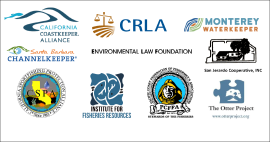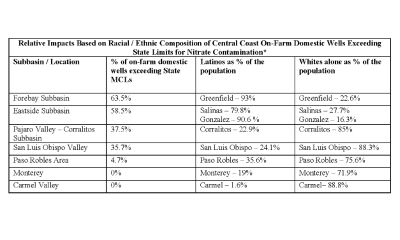Groups Challenge Water Boards’ Orders as Harmful to Disadvantaged Communities and Fisheries

PRESS RELEASE
For immediate distribution
October 30, 2023
Media Contacts:
- Chelsea Tu, Monterey Waterkeeper, (831) 204-1381, chelsea@montereywaterkeeper.org
- Sean Bothwell, California Coastkeeper Alliance, (949) 291-3401, sbothwell@cacoastkeeper.org
Sacramento – Rural Latino community and farmworker groups, environmental organizations, and commercial and recreational fishing organizations filed a lawsuit against state agencies’ September decision to strike down measures to control extensive nitrate pollution in the Central Coast region. The groups contend that nitrates in runoff from chemical fertilizers and other sources contaminate thousands of families’ wells, and that by refusing to take steps to protect the region’s polluted rivers and streams, the State Water Resources Control Board has become part of this problem. The State Board’s decision has statewide policy and downstream impacts and represents the state government’s unwillingness to confront decades of pollution by the agricultural industry—despite rising nitrate contamination and the resulting lack of clean, safe, affordable drinking water for many communities.
Nitrate contamination in the Central Coast region is widespread and increasing. Recent data gathered by the Central Coast Regional Water Quality Control Board indicates that communities of color in the Central Coast tend to experience high nitrate levels in both ground and surface waters compared to communities that are predominantly white (see table on page 3). Nitrate consumption is especially dangerous for infants and pregnant women as it can cause potentially deadly methemoglobinemia (“blue baby syndrome”). Nitrates can also cause cancer and thyroid disease in adults. The State Board’s Order frustrated the hopes of community and environmental groups that the Central Coast was on a path to cleaner water and a healthier environment. With this Order, the State Board has signaled its intention to remove similar nitrate limits from Regional Board orders in other agricultural communities.
“San Jerardo has suffered from too much nitrate in our drinking water, and we have seen our family members get sick in part because of it,” says Ileana Miranda, General Manager of the San Jerardo Cooperative. “The Water Boards must limit how much nitrate can go into our water and tell growers to stop contributing to this public health crisis as soon as possible.”
The broad coalition challenged the State Board’s decision to overturn the Central Coast Agricultural Order (Ag 4.0) adopted by the Regional Board in 2021. Ag 4.0 was a groundbreaking effort to regulate nitrate 2 contamination caused by over-application of chemical nitrate fertilizers: for the first time, it set hard numeric limits on fertilizer use. However, the State Board decision struck down the Regional Board’s limits and required that the Regional Board approve a new order without enforceable limits. The State Board also upheld the Regional Board decision not to apply buffers that would protect streams, rivers and wetlands from toxic pesticides while providing critical habitat to Central Coast fisheries, including threatened Steelhead. Without nitrate limits and stream buffers, Regional Board evidence suggested that discharges would violate water quality plans.
“Chemical fertilizers in our water are causing us harm. That is what we are fighting for—to limit fertilizers and move toward less harmful solutions,” said Manuel Barrera, President of the Comité de Salinas, which is composed of residents living within Central Coast communities affected by the nitrate discharge the State Board is charged with regulating.
Challenging the decision are the Comité de Salinas; San Jerardo Cooperative, a farmworker cooperative; California Sportfishing Protection Alliance; Pacific Coast Federation of Fishermen’s Associations; Institute for Fisheries Resources, Monterey Coastkeeper; California Coastkeeper Alliance; Santa Barbara Channelkeeper; and the Otter Project. California Coastkeeper Alliance, Environmental Law Foundation, California Rural Legal Assistance, and Stanford Environmental Law Clinic represent the petitioners.
“Many of the Central Coast’s rivers near low-income communities of color, like the Salinas River, have high levels of nitrate and pesticides,” says Chelsea Tu, Executive Director of Monterey Waterkeeper. “It is simply unacceptable that disadvantaged communities cannot drink, fish, or swim in their waters.”
“We are tired of the empty promises by our Water Boards to ensure all Californians have access to swimmable, drinkable and fishable waters,” says Sean Bothwell, Executive Director of California Coastkeeper Alliance. “The lack of enforceable groundwater limits and surface water protections only perpetuates the status quo, and the status quo is untenable for California’s disadvantaged communities.”
“The State Board’s gutting of Ag Order 4.0 violates state laws that require the Water Board’s to protect our water,” said Nathaniel Kane, Executive Director of Environmental Law Foundation, which represents several petitioners. “This coalition is suing to enforce those laws.”
Public comment before the State Board overwhelmingly favored requiring fertilizer application and discharge limits—and included comments from numerous Latino farmworkers and low-income residents throughout the Central Coast. Testimony included concern that farmers often apply fertilizer dramatically exceeding what crops need, and that reduced nitrate application would not harm crops.
Maricruz Ladino, a member of the Comité de Salinas, brought the issue back to the heart of the matter: “May we never forget that there are three things that human beings and all living things need to live: air, light, and water. We need to be aware of the consequences of pollution and find solutions and support these solutions for our communities and our families.”
The coalition filed their lawsuit on Friday, October 27 in the Superior Court for the County of Sacramento. Agriculture industry groups filed a lawsuit on different grounds in mid-October.
###


Table data sources: U.S. Census Bureau, Central Coast Regional Water Quality Control Board

